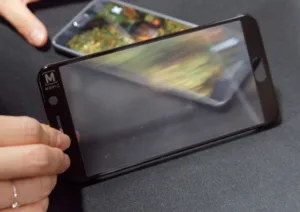Analogix was showing how its DisplayPort-based Slimport products could be used for VR applications, especially as it has developed SlimPort to MIPI display controllers that are available in single MIPI, dual Mipi or dual display, dual MIPI configurations. Resolutions up to 2560 x 1600 at 120Hz or DCI-4K at up to 120Hz. The chips are expected to be available this quarter. The company is working with Royole, among others. The company is also working still on selling its Nano-console and is also developing Continuum and similar systems for connecting smartphones to displays. Analogix is working with a company that is developing a ‘hybrid’ solution that allows Android to run on a smartphone, while a version of Linux, to support desktop computing, is also running on the smartphone. We expect to meet up with Analogix at MWC next month, so we’ll get some more details then.
Corning was showing Gorilla Glass 5 (Improved Gorilla Glass 5 is Now Available) at the Pepcom event and highlighting the improved drop strength. It is being used by Samsung (in the ill-fated Note 7, although Corning didn’t point this out at the event!), Oppo, HTC, Acer and Asus. The company was also showing its SR+ glass which has ‘sapphire-like’ strength combined with low reflectivity and which is for smartwatches (it’s in Samsung’s Gear 3). The company also highlighted Gorilla Glass in automotive applications.
We have reported on the work being done by the Fraunhofer IIS to develop its technology for light field capture and, at CES, the organisation was showing how its processing can be used in VR applications. The light field allows six degrees of freedom within a captured light field. The group has previously shown its multiple camera array capture, but has also developed a single sensor microlens-based technology. The Fraunhofer IOF in Jena is developing a twenty megapixel sensor that is extremely flat (just 3.5mm) which means that slim phones can be developed that do not have a protruding camera lens (the camera bump). The camera can work in both directions so that a single sensor can be used for world- and user-facing cameras. It can develop sensors up to four or five megapixels that could be as thin as 2mm.
A very unusual optical development is a ‘slit camera’ that uses microlenses beneath a slit in the case that can capture an image which, when processed, is equivalent to one taken through a traditional lens.
 Fraunhofer was showing its FacetVision technology which puts the camera behind the slit on the side of this prototype. Image:Meko
Fraunhofer was showing its FacetVision technology which puts the camera behind the slit on the side of this prototype. Image:Meko
HKC was, as usual, not really interested in promoting itself by marketing, but keen to sell its products. It told us that all the products on the booth were new and there were a notable number of curved TVs and monitors. HKC has been increasing its share of the OEM business globally for TVs and is planning the third of the Chinese G11 plants. It is in the process of building its first TFT fab, a G8.6 fab in Chongqing that is expected to start making panels in Q2 2017. The fab shares sizes with Innolux and IHS reports that the company will focus on 32″ and 50″ panels, initially, as it can take advantage of other panel suppliers dropping out. IHS has reported that the HKC business plan is for 3.3 million panels in 2017.
HP did not have a booth at CES, but was at the Pepcom evening event and the firm was highlighting its existing HP Z27n which is a narrow bezel IPS monitor, but there were no new monitors. The company was also showing the Gen 2 Sprout Pro, an upgrade of the Pro version of the Sprout which was first shown at CES last year. The latest sprout has a new design, supports FullHD and touch and there is a new active stylus that supports 2048 levels and palm rejection. It has a better GPU (an Nvidia 960) and CPU (7th gen Core i7) and 3D sensors (replacing an Intel Realsense sensor). It has a 14 megapixel camera and will start shipping in March.
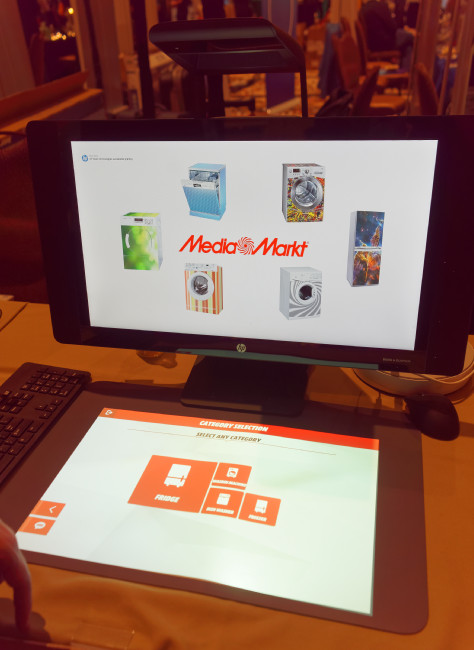
The company has been getting more support from software vendors and applications have been developed such as using the device for ‘guided assembly’ of production, an application developed with GE. MediaMarkt in Portugal is using the Sprout in a retail application.
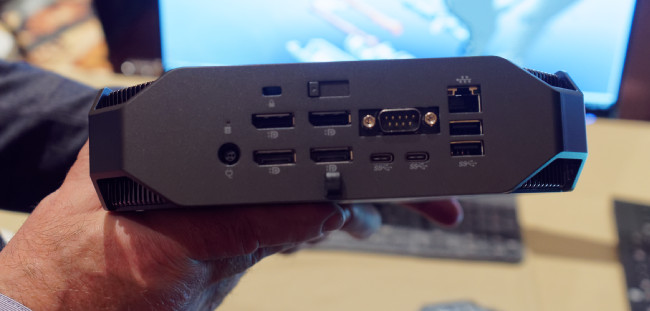 HP was showing the Z2 Workstation which is very small, but still supports multiple (up to 6) displays. Image:Meko
HP was showing the Z2 Workstation which is very small, but still supports multiple (up to 6) displays. Image:Meko
Huawei‘s press event clashed with another that we had to attend, but its main announcement was about the Honor sub-brand, which is its entry level phones. Fortunately, the company was at Pepcom so we got to see the new Honor 6X (6X is a great name – it’s a popular beer in the UK!) which has a 5.5″ FullHD LCD display and uses a HiSilicon Kirin 655 application processor. There are dual cameras, 12 megapixel and 2 megapixels, with 8 megapixels on the other side. Memory is 3GB + 32GB or 4GB + 64GB. Pricing will be $249 initially, but it may come down. The company was also showing the Mate 9 flagship phone which launched in early November. It has a 5.9″ FullHD UPS display and uses a Kirin 960 with a Mali-G71 MP8 GPU. Memory is 4GB + 64GB, expandable with a microSD. The camera uses Leica optics with dual 20 megapixels and 12 megapixel main cameras and an 8 megapixel selfie camera. Video capture is up to 2160/30P or 1080P/60P. Connection is via a USB 2.0. Pricing in the US is ‘about $600’. The phone is 7.9mm thick.
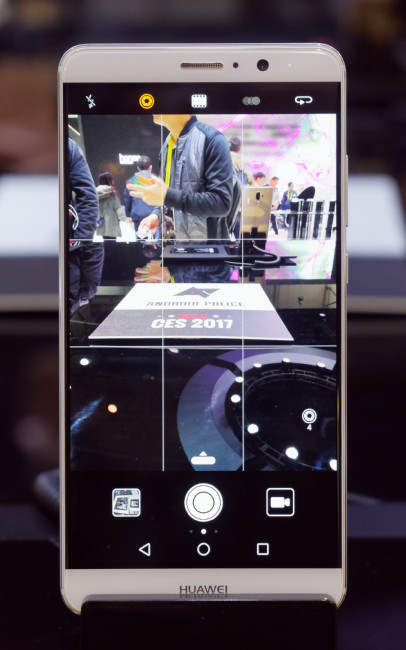 Huawei’s Mate 9 – Image:Meko
Huawei’s Mate 9 – Image:Meko
Lattice was showing its Snap 60GHz technology being used to support DisplayLink (DisplayLink Demos Wireless Connections)
We met with Leap Motion in the Westgate. It was a slightly strange meeting as the company seemed surprised that we were interested, but we’re all about the HMI and the marketing person we met said that the firm is about “Revolutionising the human/computer interface”, so it seemed logical to us (and anyway, any company where Candice Brown-Elliot, a sometime Display Daily contributor, is a Veep, must be interesting!). The company makes motion and hand trackers and aims to help with ‘manipulating digital information’. It claims a developer community of 300,000. The company has focused on tracking hand movements and it claims a breakthrough in working out how to deal with difficult issues such as occlusion. For example, if a headset is tracking the hands from a camera, or two, what happens when the fingers are bent and part of the hand conceals the fingers?
In December, the company announced a new platform for mobile applications, but unfortunately this wasn’t available to demo when we visited. The platform uses dual infrared detectors and LED illumination. We asked what the cost was and we heard it was ‘$20’. Is that to the OEM or the user, we asked? The answer was ‘no comment’. So it costs somebody, somewhere, $20, but it’s unclear who! Anyway, the firm is partnering with brands on embedded solutions for the technology and US/Chinese brands are expected to show solutions by the end of 2017.
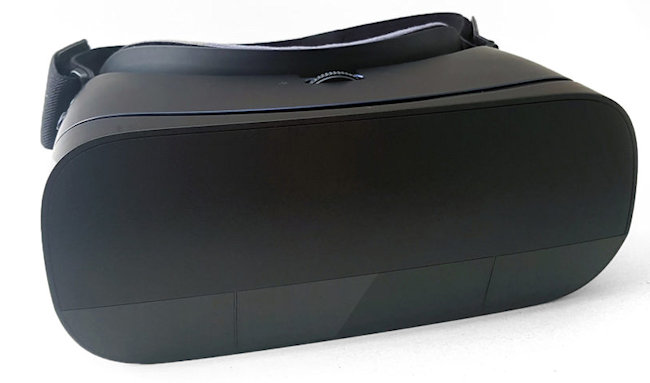 Leap Motion’s hand tracker on the front of a VR headset.
Leap Motion’s hand tracker on the front of a VR headset.
Mopic was in the Sands Innovation area and was showing autostereo 3D that uses the firms own engine to create stereo content and a clip-on overlay case to split the images. The engine uses head tracking to optimise the image for the viewer.
Mopic has an AS3D Phone Case
OperaTV was showing a range of solutions for TV makers. The company started by telling us that the Opera App store is now rated as the third largest mobile app store. The company’s combination of a rendering engine together with a certified app store is proving attractive for TV makers. Opera claims 50 partners for its certification programme and told us that its technology in 40 million devices, globally.
We’ve been reporting on Peraso, which is working on WiGig, for a couple of years now. At the moment, the company is focusing on chips that enable 802.11ad (WiGig) for data and has designed dongles that enable routers to add 802.11ad support if they have USB, or to enable client devices. New at the show was a dongle with Type-C connectivity. 802.11ad is continuing to develop, but slowly. The use of WiGig for display has not been helped by the fact that Intel’s WiGig docking solutions (e.g. used by HP and Dell) are basically proprietary. A key point is that WiGig does now have native Windows 10 support. The firm’s latest chipset uses beam forming and should be in mass production in Q2. At the moment, datarates are in the order of 2-3 Gbps, but eventually, Peraso expects datarates to get to 20/30Gbps.The company had a demo of how fast a data file can be transmitted with the technology. The company is also working with DisplayLink and Qualcomm.
Reticare is a company that we have reported on several times. The company has developed filters that can be fitted to displays on mobile display, particularly, to filter out ‘damaging’ blue light. The company told us that it has a lot of interest from very large companies that are becoming interested in the topic. It also told us that it is very close to getting its accessories sold by ‘major retailers’.
(I remain conflicted about this topic. If blue light is really as damaging as Reticare claiams, on the basis of real research from the University of Madrid, then the industry should take it very seriously. However, I don’t regard myself as sufficiently qualified to really judge the quality of the science. Hmm… BR)
Roku was at Pepcom event and was happy to have reported that one in eight of the TV sets recently sold in the US use Roku technology. We asked about competition from Amazon, which has seen its Fire technology being used on some TVs. Roku said that it had a mixed relationship with Amazon as it supports the firm’s OTT software. However, it feels it has an advantage as more of the current OTT services are supported because Roku is neutral.
Scalable Graphics is a French company that works on cloud computing (it works with Nvidia on virtual workstations, for example). At CES, the company was in the Sands Expo and was showing a wireless solution for streaming video to VR headsets, using the H.264 codec at 40-80Mbps. There are two versions, for consumers (12ms latency, $300) and for professionals (8ms latency, $1,500). The company has a solution that works with the Vive and, currently, the Oculus SDK2,
TCL Alcatel was showing a new phone, a version of the A3XL which has a 6″ IPS with a ‘slip-proof’ plastic full lamination and it supports dual SIMs and an microSD card. The resolution of the display is a surprisingly low (for the size) 1280 x 720. The camera is an 8MP/5MP combination, but the firm told us that it might receive a 16MP/8MP combination. The price is likely to be in the $200 to $300 range. The company was showing the ‘Plus’ 10″ mobile device which we saw at IFA and which will launch in the US at around $370 in Q2. (Alcatel Has Stand-Alone Headset). TCL was not showing Blackberry devices. The Move is a new smartwatch with a 1.39″ AMOLED that can track fitness and receive calls via an attached smartphone.
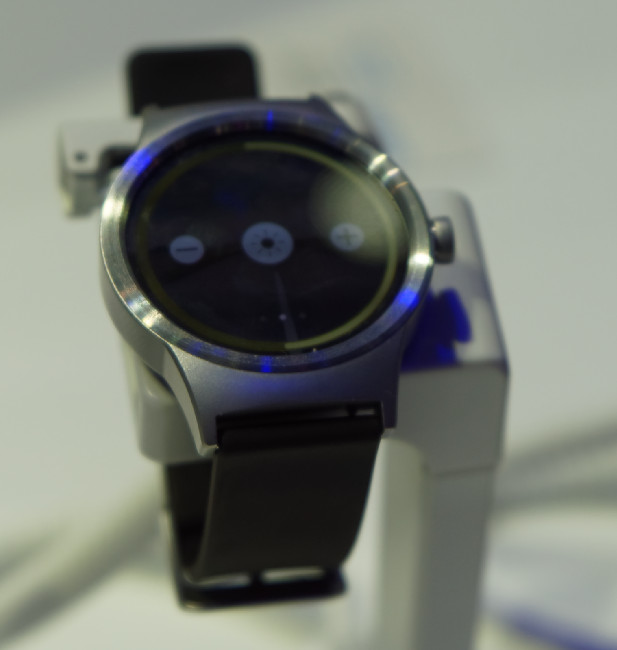 TCL Alcatel’s Move smartwatch. Image:Meko
TCL Alcatel’s Move smartwatch. Image:Meko
Tianma was showing its small displays but told us that it had nothing new since our report at Electronica (Electronica 2016 Round-up).
Unipixel is a company that has been around a while. The firm started with a novel flat panel technology using frustrated TIR as a kind of shutter, but pivoted to develop touch and last year acquired Atmel’s metal mesh-based capacitive touch sensor business in April 2015. In the second half of 2016, the company really picked up momentum in winning clients and said in December that it had got 25 design wins in 2016. The company says that it has advantages over others with its technology, especially as makers want to go to narrower bezels. ITO struggles to get down to the narrow bezels that Unipixel can achieve as its better conductivity means that its signal lines can be very thin. The firm’s proprietary patterns also help as it only needs a one-ended electrode. The company also said that its technology can be used without a cover lens and can even be used with an acrylic coating. The company also told us that it had tested the materials in flexible applications and had bent a system through 180º 240K times while maintaining performance.
The USB Implementers Forum (USB-IF) is enjoying life. This time last year, USB Type-C looked like a good idea, with lots of supportive backers, but it didn’t really have momentum. You can’t say that now.The group has been developing an authentication scheme for USB for power delivery, as system makers have been concerned about badly-implemented systems that may ‘fry’ the system. The scheme allows device makers to develop a ‘defensive mode’ that can be enabled if the device delivering power cannot be authenticated. The USB-IF is the authority for the authentication. The group has als been developing a certified charges scheme for power delivery and there are 11 chargers currently certified. USB systems typically support 15W/27W/45W or 60W as standard, although other power levels are OK.
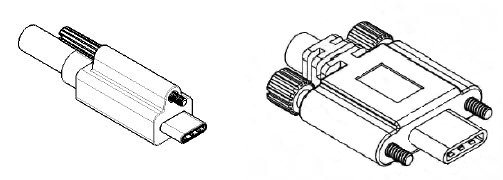 There are now two Locking USB options for Type-C
There are now two Locking USB options for Type-C
Another development is USB Audio 3.0 which has been developed to assist the removal of 3.5mm jacks from mobile devices. It is very ‘power friendly’ and although the specification was only released in September, products are already on the market. There has also been work done to develop a Type-C locking connector (with one or two locking screws). Although this is not desperately sophisticated, it will meet the need for some applications where disconnection would be a critical problem. In automotive applications, for example, every connection in a car is locking. For USB to be used, it also has to have that option.
The Forum has been working on labelling and has developed two new ‘trident’ graphics for 5Gbps and 10Gbps superspeed connections.
We have talked before about the desire of the USB-IF to cover every connection to a device. To do that, it has to drive the display as well and a display group is ‘just forming’. (We assume that it will try to develop a non-proprietary alternative to DisplayLink – Man. Ed.)
Xiaomi was showing its Mi Mix phone which has features such as an ultrasonic proximity sensor and piezo speaker to allow as much as possible of the front to be display surface and the display is a 6.4″ diagonal with an unusual resolution of just above FullHD at 2040 x 1080 (17:9). As we pointed out when it was launched, the top corners of the display appear to be curved. The body of the phone is made from ceramics and the phone has a 2.35GHz Snapdragon 821 with 6GB of RAM and 256GB of ROM. There’s a 4400mAh battery that supports Quick Charge 3.0. The camera does not stick out from the back of the device and is a 16MP unit, with 5MP on the front. The unit supports 192kHz 24 bit audio. The phone costs $578.
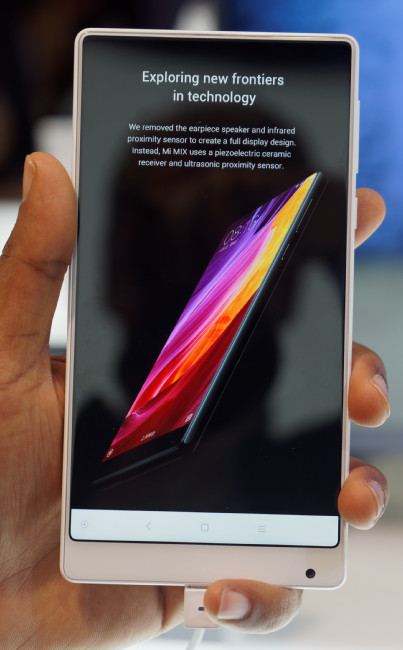 Xiaomi’s Mi Mix phone was the most innovative at CES. Image:Meko
Xiaomi’s Mi Mix phone was the most innovative at CES. Image:Meko
The Mi Note 2 was announced in China in October (Xiaomi Mi Note 2 & Mi Mix Innovate) but this was our first chance to see it. It uses an LG OLED 5.7″ FullHD display and has curved edges. It is now available globally and costs $476 in the US. Features highlighted at the show include a 22MP autofocus camera and a 4070mAh battery.
The Notebook Air 12.5″ is a Windows 10 notebook that uses an Intel Core M3 processor and has 4GB of RAM and 128GB of SD (expandable). The device has a FullHD display and is claimed to have an 11.5 hour battery life, but is very thin. It costs an aggressive (for the size) $505. There is also a 13.3″ version that uses a Core i5 processor (6th gen) with 8GB of RAM and 256GB of SSD. The bezel on the FullHD display is 5.59mm. The system costs $722.
 Xiaomi’s Notebook Air is very light and good value. Image:Meko
Xiaomi’s Notebook Air is very light and good value. Image:Meko
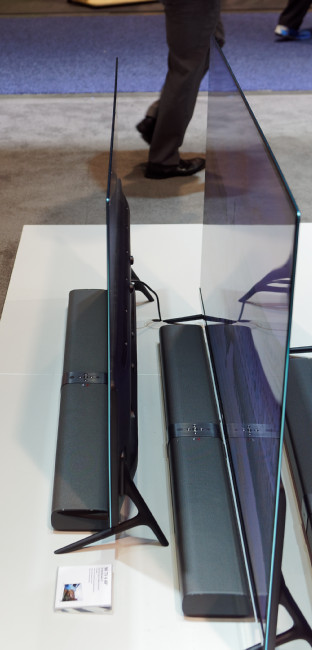 Xiaomi was also showing the MiTV4 which is available in 49″, 55″ and 65″. The TV uses a separate input connection box which also allows upward-facing speakers to enable Dolby Atmos.
Xiaomi was also showing the MiTV4 which is available in 49″, 55″ and 65″. The TV uses a separate input connection box which also allows upward-facing speakers to enable Dolby Atmos.
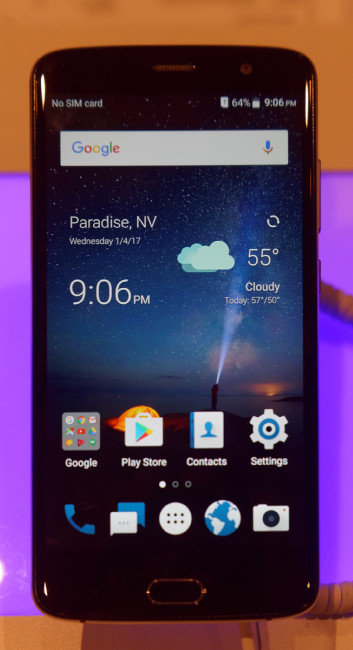 ZTE was at the Pepcom Digital Experience and was showing the Blade VH Pro phone in the US for the first time. The devices is expected to sell at around $229 and has a 5.5″ FullHD LCD display and uses a Snapdragon 625 processor. The camera has a dual 13 megapixel camera configuration and can create images using a ‘virtual aperture’ to selectively focus.
ZTE was at the Pepcom Digital Experience and was showing the Blade VH Pro phone in the US for the first time. The devices is expected to sell at around $229 and has a 5.5″ FullHD LCD display and uses a Snapdragon 625 processor. The camera has a dual 13 megapixel camera configuration and can create images using a ‘virtual aperture’ to selectively focus.
On its booth, the company had the Axon 7 Max, a Snapdragon 625 CPU with a 2.0GHz clock and with a 6″ autostereoscopic S3D display which uses a FullHD IPS LCD. The phone has 4GB of RAM and 64GB of ROM with up to 256GB of microSD expansion. The phone has dual 13MP cameras on the rear and the same resolution on the front.
The Blade V8 phone uses a 1.4GHz Snapdragon 435 and has a 5.2″ FullHD display with a curved edge. There are dual rear cameras (13MP and 2MP) which can be used to capture depth information. This can allow processing for ‘bokeh’ depth of field effects or to create S3D images for VR viewing and the phone is ‘Daydream ready’. The phone runs Android 7. Staff described it to us as a ‘mid-tier device with a low tier price’. Pricing and release date still has to be decided.

